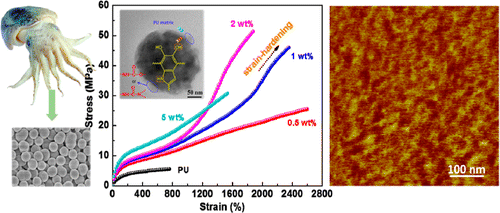Skin pigment could help strengthen foams and fabrics

Melanin is the natural molecule in animals' skin, hair and the iris of eyes that gives them color and helps protect them from ultraviolet light. Someday soon, the pigment could be found in unexpected places such as sofa cushions or clothing—but not for its hue. Scientists have found that adding a small amount of melanin to polyurethane makes it far stronger than the material by itself. Their study appears in the ACS journal Biomacromolecules.
From durable foam seating and insulation to glossy coatings and stretchy textiles, polyurethane is used in a huge range of products. Although already fairly versatile, polyurethane still has room for improvement. To make it more durable, scientists have tried adding fillers, including silica, carbon nanotubes and graphene oxide. But these efforts have often led to the enhancement of only one physical property at a time, such as tensile strength—how hard a material can be pulled before it snaps—but not toughness—how much energy it can absorb without breaking. Mingqing Chen, Weifu Dong and colleagues wanted to try a new approach: adding melanin, a biomolecule increasingly used in various other materials.
The researchers found that polyurethane containing just 2 percent melanin, extracted from the ink sacs of cuttlefish, had improved tensile strength and toughness. These properties were enhanced about 10 fold, increasing from 5.6 megapascals and 33 megajoules per cubic meter in plain polyurethane to 51.5 MPa and 413 MJ/m3, respectively. Polyurethane by itself could stretch 770 percent before breaking, whereas the melanin-infused version stretched 1,880 percent before rupturing.
More information: Yang Wang et al. Superior Performance of Polyurethane Based on Natural Melanin Nanoparticles, Biomacromolecules (2016). DOI: 10.1021/acs.biomac.6b01298
Abstract
Melanin, a kind of well-known multifunctional biomacromolecules that are widely distributed in natural sources. In this work, polyurethane (PU)/melanin nanocomposites with enhanced tensile strength and toughness were successfully fabricated via in situ polymerization. It was found that the tensile strength (σ), elongation-at-break (εmax), and toughness (W) were improved from 5.6 MPa, 770%, and 33 MJ/m3 for PU to 51.5 MPa, 1880%, and 413 MJ/m3 for PU/melanin (2 wt %) nanocomposite, respectively. Micromorphology indicated that individualized melanin nanoparticles were specifically linked to the hard domains of PU chains and fine dispersed in matrix. FTIR, DSC, and AFM results suggested melanin induced an improvement in degree of phase separation, which resulted in remarkable enhancements in mechanical properties of PU. However, with further increasing content of melanin, a relatively large-scale phase separation was formed and led to a decrease in mechanical properties of PU. In addition, interactions between melanin and hard segments of PU were increased, leading to a higher TgHS. Moreover, the dynamic mechanical properties and rheological behavior of PU/melanin nanocomposites were further investigated.
Journal information: Biomacromolecules
Provided by American Chemical Society

















